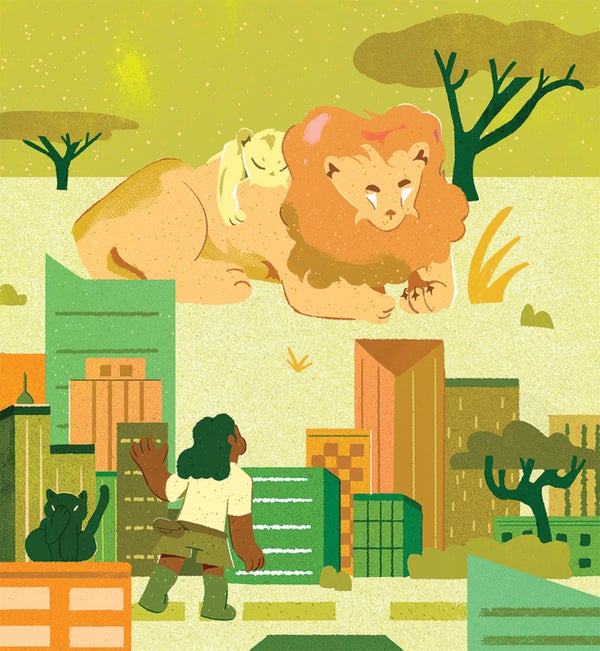We often ask humanity to reflect on nature's benefits and on what we can do to promote environmental sustainability. These are noble asks in light of our climate emergency, but reflection is not enough. We need action on multiple fronts.
Urban settings, far from being ecological wastelands, are rife with biological activity. Cities have been described as essential to climate change solutions, but they can also raise the kinds of ecologists that will bring us into a more inclusive biological future.
I am a Black wildlife biologist from Philadelphia. My presence in ecology has challenged assumptions about not only what a biologist looks like but also where a biologist comes from. Throughout the world there are city dwellers like me who have diverse, broad-based skill sets with the potential to make them better biologists.
On supporting science journalism
If you're enjoying this article, consider supporting our award-winning journalism by subscribing. By purchasing a subscription you are helping to ensure the future of impactful stories about the discoveries and ideas shaping our world today.
As an applied ecologist, I travel the world studying the behaviors and interactions of carnivores for their conservation—literally lions, tigers and bears. I bathe in rivers, sleep in tents, poop in holes, get charged at by elephants, jump from helicopters and hike many kilometers a day. The training ground I now provide for young scientists is a far cry from the one I was thrust into when I decided to pursue ecology.
In the U.S., ecology was and is predominantly white and conducted in rural landscapes. I stood out among my peers for not having a history of camping, fishing, hunting or hiking. I had yet to recognize that Philly, with its four seasons and abundance of squirrels, row homes and festivals, was actually my first ecological classroom. There I witnessed feral cats eating birds and rats, people shooing bats from their homes and snakes being killed by lawn mowers. This is as much ecology in action as anything we witness in fields and forests.
City dwellers see the world through a different lens. Our perspective on what a neighbor is gets shaped by the fact that we share space in ways not found in the traditional dichotomy of “natural versus constructed.” Urban wild animals exhibit myriad features and behaviors that set them apart from their rural counterparts: they may be bigger, eat more diverse food sources, are active at different times of the day, move differently and have different personalities. Some biologists argue they are even “smarter.”
Urban wildlife balances more risks—such as exposure to roads, chemical toxins and diseases from domestic animals—with rewards. Some of those rewards come from humans providing food and from the distribution of our parks and water bodies. Others, particularly for carnivores, are natural resources such as rodents. This dynamic, coupled landscape where nature meets people can also dramatically influence human societies.
Our interactions with nature are ubiquitous. Urbanites' intuition is sharpened by risks—we know a sketchy street, and we lock our doors. Our ability to assess threats and our awareness regarding safety influence our behaviors and choices, much as they do for urban wildlife. This interplay affords us an understanding through proximity.
In our professional lives as biologists, our exposure to diverse communities in cities initiates cultural sensitivities that help to promote inclusivity. When you experience the scarcity and rationing of resources in a crowded city, you understand resource allocation at a deeply personal level. We bear witness to evolution and the wealth of nature's innovation through flowers budding through concrete and birds of prey eating carrion on highways.
Such heterogeneity in cities plants unconscious seeds of appreciation for diversity, tolerance and empathy that can benefit the natural world. The framing of urban areas as degraded, depauperate and deficient leads people to undervalue their inhabitants—wildlife and humans alike. By training more biologists from urban settings, we are creating an agenda that has broader societal relevance. Most of the world's population now accesses green and blue spaces, as well as wildlife, within urban neighborhoods. Nature is no longer only pristine wilderness; it includes sounds of human laughter, trash trucks and sirens.
We urbanites are gritty, resourceful and imaginative. We need more capacity, more participation, more energy and more innovation in science to create solutions to combat environmental degradation and halt biodiversity loss. Identifying this talent across cities presents an easy remedy.
JOIN THE CONVERSATION ONLINE Visit Scientific American on Facebook and Twitter or send a letter to the editor: editors@sciam.com
*Editor’s Note (4/22/22): This sentence was edited after posting to correct the description of the author’s position.
